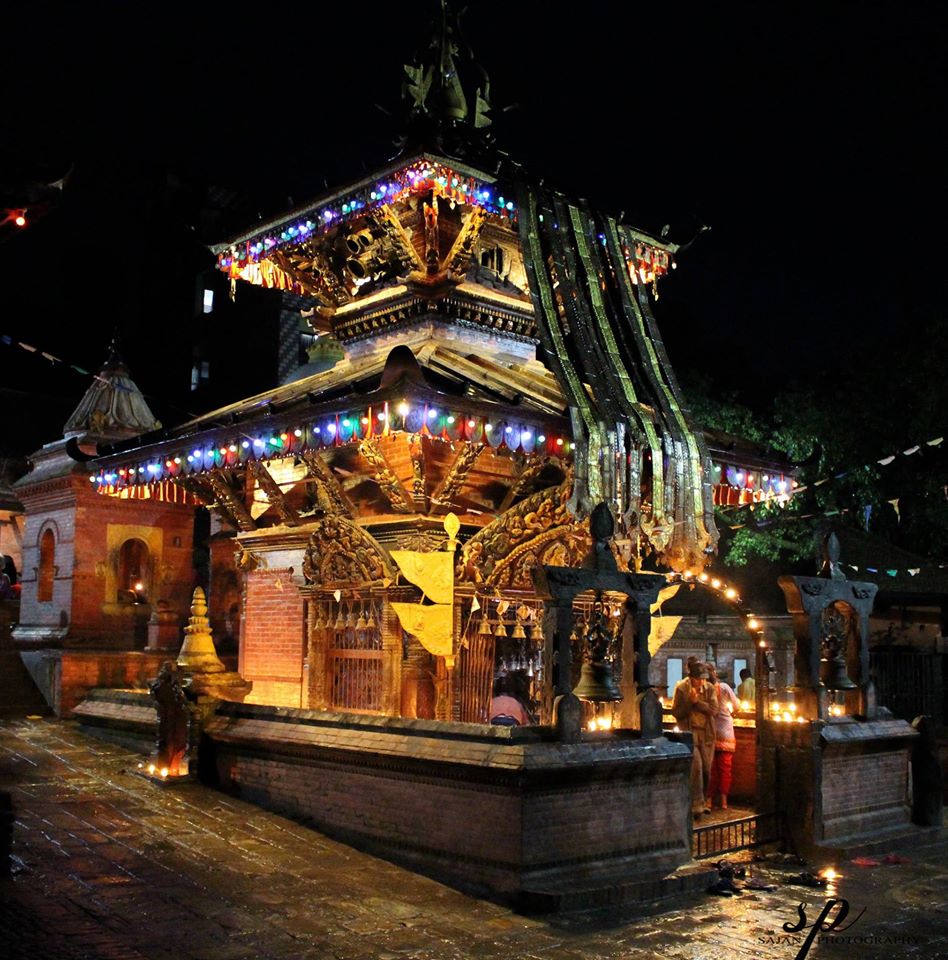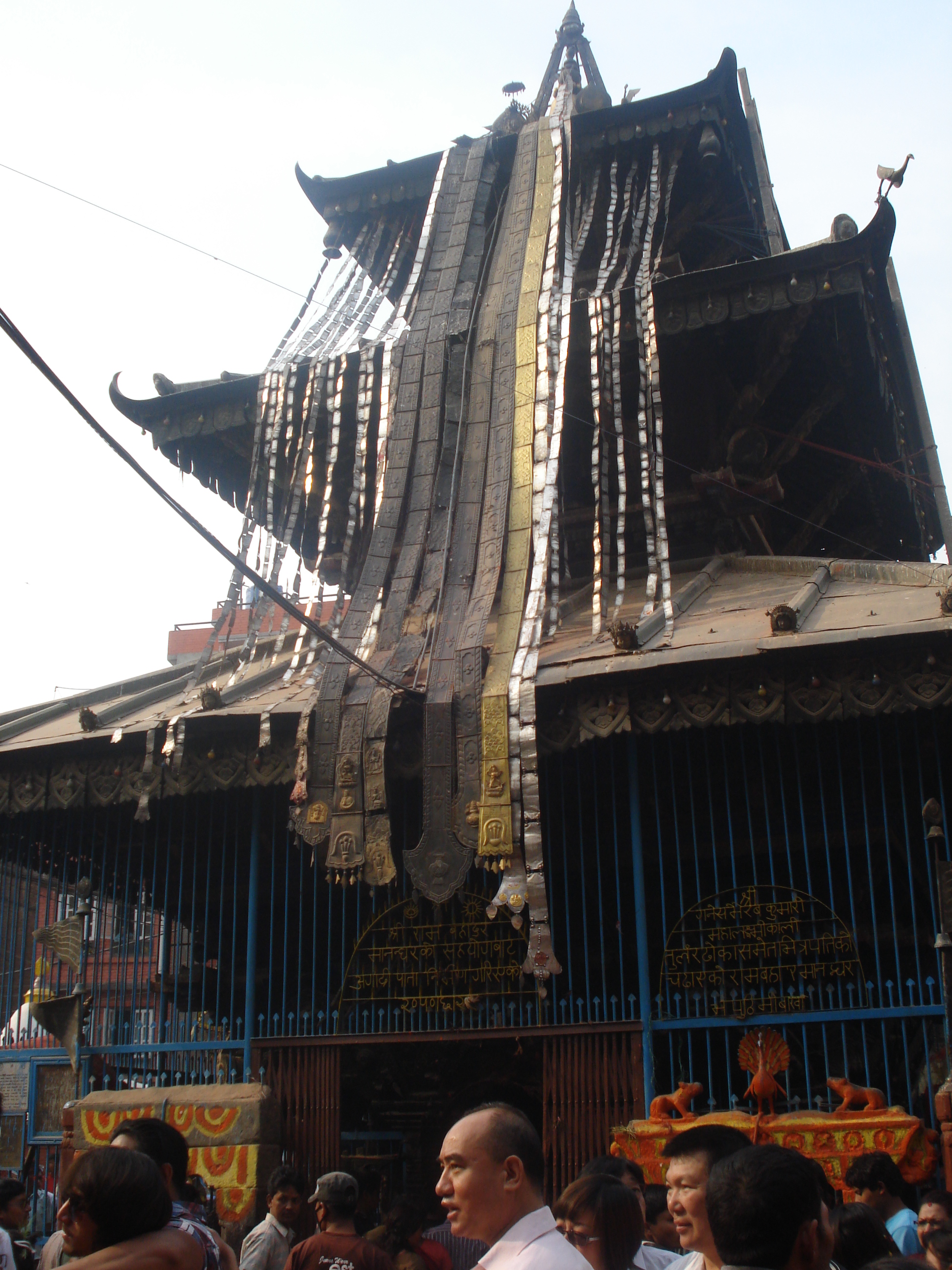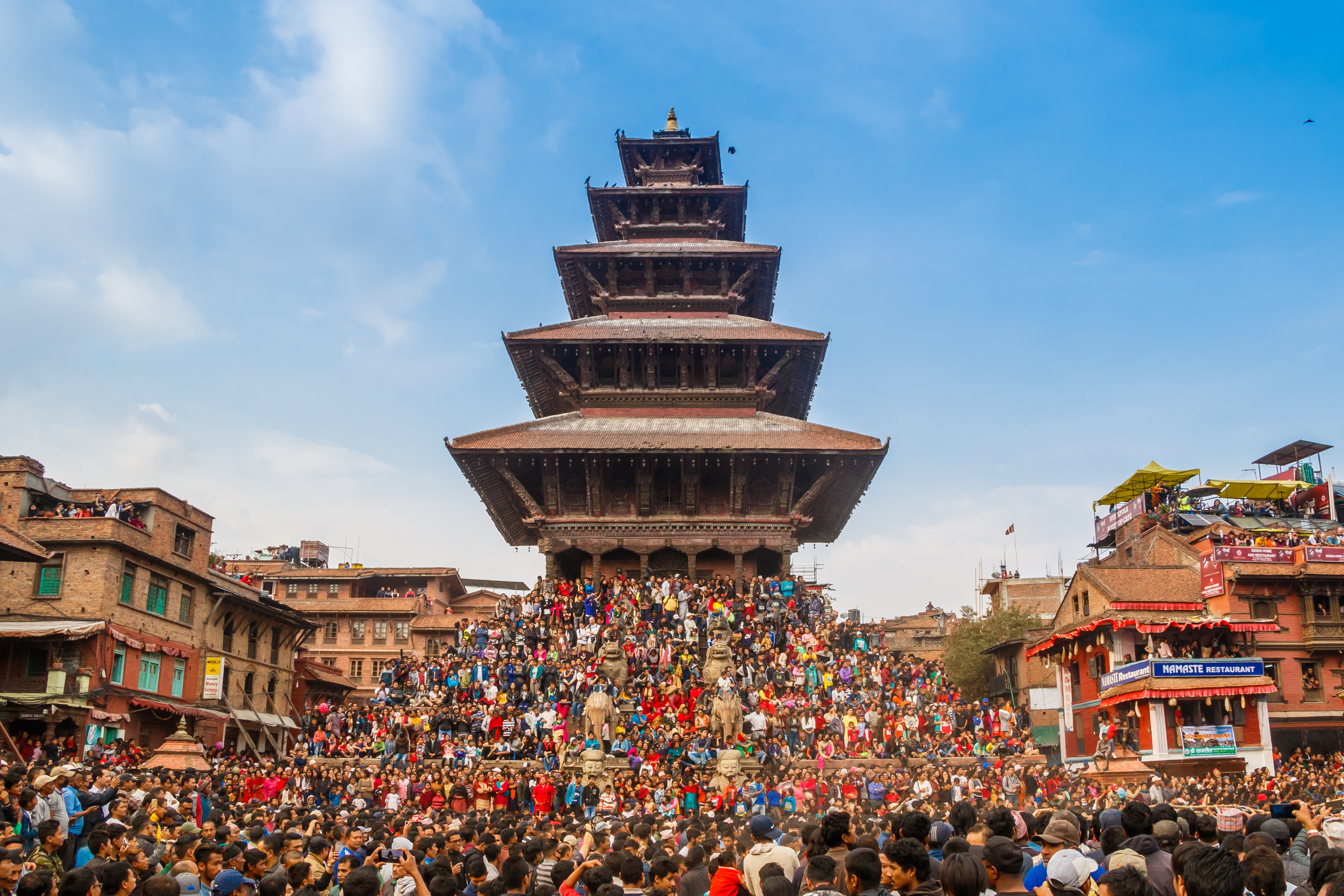|
Siddhikali Temple
Siddhikali Temple is a Hindu temple located in Madhyapur Thimi, Thimi, Nepal. The two storeys roofed temple is dedicated to Lord Kali, Shiva and Ganesha, Ganesh. It is also believed that this Shaktipeeth is formed due to the falling of right eye of the corpse of Sati_(Hindu_goddess), Sati. This place is located in Inayekwo, in the north west of Thimi. The temple is also known as ''Inayekwo Dyo'' in Nepal Newar language, Bhasa language. And Siddhikali Temple is also known as Chamunda, one of the goddess of Astamatrika. The majestically impressive Siddhikali temple has numbers of ''Pataa'' streaming down the front. There's a ''Satah'' (rest-house) opposite to temple and multiple ''Falcha'' (Inns) and several smaller shrines (Bhairav, Shiva Temple, Saraswoti Temple, Bhimsen Temple, Basundhara Temple, Sahsrabhuj Lokeshwor Temple, Buddha Chaitya) to the rear and nearby and several stone taps around the place. The artwork around the Siddhikali temple is fantastic and worth a close inspe ... [...More Info...] [...Related Items...] OR: [Wikipedia] [Google] [Baidu] |
Madhyapur Thimi
Madhyapur Thimi, also known as Thimi, ( ne, मध्यपुर थिमि) is a municipality in Bhaktapur District in the Bagmati Zone of central Nepal. Thimi lies between Kathmandu, Lalitpur and Bhaktapur in the Kathmandu Valley. It is one of the ancient cultural and historical places along the trade route from Bhaktapur to Kathmandu. The city is situated on elevated land and occupies an area of , divided into nine administrative wards. The mayor was Madan Sundar Shrestha of the Communist Party of Nepal (Unified Marxist–Leninist) of Nepal. Archaeology There are indications that the city may be as old as 3000 BC. A recent work by Mohan Pant and Shuji Funo compared the very regular grid layout of Thimi to other ancient cities in the Indus valley and Nepal. The details of the grid dimensions of city blocks are very close to those of Mohenjo-daro and Sirkap (part of ruins near Taxila) in Pakistan; also Patan, Nepal. The authors found that plot dimensions measure by , and are ... [...More Info...] [...Related Items...] OR: [Wikipedia] [Google] [Baidu] |
Traditional Dhwakha
A tradition is a belief or behavior (folk custom) passed down within a group or society with symbolic meaning or special significance with origins in the past. A component of cultural expressions and folklore, common examples include holidays or impractical but socially meaningful clothes (like lawyers' wigs or military officers' spurs), but the idea has also been applied to social norms such as greetings. Traditions can persist and evolve for thousands of years—the word ''tradition'' itself derives from the Latin ''tradere'' literally meaning to transmit, to hand over, to give for safekeeping. While it is commonly assumed that traditions have an ancient history, many traditions have been invented on purpose, whether that be political or cultural, over short periods of time. Various academic disciplines also use the word in a variety of ways. The phrase "according to tradition", or "by tradition", usually means that whatever information follows is known only by oral tradition, ... [...More Info...] [...Related Items...] OR: [Wikipedia] [Google] [Baidu] |
Guthi
Gosthi or Guthi ('';'' Newar: , romanized: '; etymologically from ) is a social organization that maintains the socio-economic order of Nepalese society.Title:नेपाली संस्कृतिका छटाहरु, Author:Mangala Devi Singh, Publisher:Dr.Meeta Singh The guṭhī system is considered to be in operation since the Kirati era like king Yalamber's descendants and later adopted by the Lichchhavi during the Lichchhavi era, with the first practice being recorded in scriptures on pillars erected at Changu Narayan temple, which in itself is regarded to be the oldest dated inscription of Nepal. Currently, most of the guṭhīs are either defunct or a vestigial representation of what used to be the most powerful organized community of the Newars. However, some of these guṭhīs still exist with its own purpose, and their functions are governed by internal unwritten rules; often kept secret and revealed only to its members. During the course of time, the ma ... [...More Info...] [...Related Items...] OR: [Wikipedia] [Google] [Baidu] |
Bisket Jatra
Biska Jatra, is an annual event in Bhaktapur, Dhapasi, Madhyapur Thimi and Tokha and other places in Nepal. The festival is celebrated at the start of the new year on the Bikram Sambat calendar, however, the festival itself is not related to Bikram Sambat. Origin Legend has it that this celebration is the "festival after the death of the serpent". Various areas of Bhaktapur city celebrate this festival according to their own rituals. The most eventful places are Taumadhi Square and Thimi Balkumari. A chariot carrying the statue of Lord Bhairava is pulled by hundreds of people to towards upper (''Thaney'') and lower (''Koney'') neighbourhood as tug of war. Approximately a month earlier, the chariot is assembled near the Nyatapola temple. Observations The signature event on Bhaktapur Taumadhi kicks off the Biska jatra "dya koha bijyaigu" which means the god Bhairava is brought outside from its temple for the festival, it is a tug-of-war between the Thane (upper) and Kone (lower ... [...More Info...] [...Related Items...] OR: [Wikipedia] [Google] [Baidu] |
Vijayadashami
Vijayadashami ( sa, विजयदशमी, Vijayadaśamī, translit-std=IAST), also known as Dussehra, Dasara or Dashain, is a major Hindu festival celebrated at the end of Navaratri every year. It is observed on the tenth day in the Hindu calendar month of Ashvin, the seventh month of the Hindu Luni-Solar Calendar, which typically falls in the Gregorian months of September and October. Vijayadashami is observed for different reasons and celebrated differently in various parts of the Indian subcontinent. In the southern, eastern, northeastern, and some northern states of India, Vijayadashami marks the end of Durga Puja, remembering goddess Durga's victory over the buffalo demon Mahishasura to restore and protect dharma. In the northern, central and western states, the festival is synonymously called Dussehra (also spelled Dasara, Dashahara). In these regions, it marks the end of Ramlila and remembers god Rama's victory over Ravana. Alternatively, it marks a reverence for o ... [...More Info...] [...Related Items...] OR: [Wikipedia] [Google] [Baidu] |
Dashain
Dashain or Bada'dashain, also referred as Bijaya Dashami in Sanskrit, is a major Hindu religious festival in Nepal. It is also celebrated by Hindus of Nepal and elsewhere in the world, including among the Lhotshampa of Bhutan and the Burmese Gurkhas of Myanmar. The festival is also referred as Nauratha, derived from the Sanskrit word for the same festival Navaratri which translates to ''Nine Nights''. A version of this festival is celebrated as Navaratri, Dussehra or Dashera by Hindus in India, although rites and rituals vary significantly. It is the longest and the most auspicious festival in the Bikram Sambat and Nepal Sambat annual calendars, celebrated by Nepali Hindus, along with their diaspora throughout the globe. In Nepal, it is also known as the biggest festival in the country and is the longest national/public holiday, 5 days to be exact. It is the most anticipated festival in Nepal. People return from all parts of the world, as well as different parts of the country, ... [...More Info...] [...Related Items...] OR: [Wikipedia] [Google] [Baidu] |
Newar People
Newar (; new, नेवार, endonym: Newa; new, नेवा, Pracalit script:) or Nepami, are the historical inhabitants of the Kathmandu Valley and its surrounding areas in Nepal and the creators of its historic heritage and civilisation. Page 15. Newars form a linguistic and cultural community of primarily Indo-Aryan and Tibeto-Burman ethnicities following Hinduism and Buddhism with Nepal Bhasa as their common language. Newars have developed a division of labour and a sophisticated urban civilisation not seen elsewhere in the Himalayan foothills. Newars have continued their age-old traditions and practices and pride themselves as the true custodians of the religion, culture and civilisation of Nepal. Newars are known for their contributions to culture, art and literature, trade, agriculture and cuisine. Today, they consistently rank as the most economically and socially advanced community of Nepal, according to the annual Human Development Index published by UNDP. Nepal ... [...More Info...] [...Related Items...] OR: [Wikipedia] [Google] [Baidu] |
Newar Language
Newar (), or Newari and known officially in Nepal as Nepal Bhasa, is a Sino-Tibetan language spoken by the Newar people, the indigenous inhabitants of Nepal Mandala, which consists of the Kathmandu Valley and surrounding regions in Nepal. "Nepal Bhasa" literally means "Nepalese language", however the language is not the same as Nepali (Devanāgarī: नेपाली), the country's current official language of the central government. The two languages belong to different language families (Sino-Tibetan and Indo-European, respectively), but centuries of contact have resulted in a significant body of shared vocabulary. Newar was Nepal's administrative language from the 14th to the late 18th century. From the early 20th century until democratisation, Newar suffered from official suppression. From 1952 to 1991, the percentage of Newar speakers in the Kathmandu Valley dropped from 75% to 44% and today Newar culture and language are under threat. The language has been listed ... [...More Info...] [...Related Items...] OR: [Wikipedia] [Google] [Baidu] |
Hanuman
Hanuman (; sa, हनुमान, ), also called Anjaneya (), is a Hindu god and a divine '' vanara'' companion of the god Rama. Hanuman is one of the central characters of the Hindu epic ''Ramayana''. He is an ardent devotee of Rama and one of the Chiranjivis. Hanuman is regarded to be the son of the wind-god Vayu, who in several stories played a direct role in Hanuman's birth, and considered to be an incarnation or son of Shiva in Shaivism. Hanuman is mentioned in several other texts, such as the epic ''Mahabharata'' and the various Puranas. Evidence of devotional worship to Hanuman is largely absent in these texts, as well as in most archeological sites. According to Philip Lutgendorf, an American Indologist, the theological significance of Hanuman and devotional dedication to him emerged about 1,000 years after the composition of the ''Ramayana'', in the 2nd millennium CE, after the arrival of Islamic rule in the Indian subcontinent.Paula Richman (2010), ''Review: Lut ... [...More Info...] [...Related Items...] OR: [Wikipedia] [Google] [Baidu] |
Ramayana
The ''Rāmāyana'' (; sa, रामायणम्, ) is a Sanskrit literature, Sanskrit Indian epic poetry, epic composed over a period of nearly a millennium, with scholars' estimates for the earliest stage of the text ranging from the 8th to 4th centuries BCE, and later stages extending up to the 3rd century CE. ''Ramayana'' is one of the two important epics of Hinduism, the other being the ''Mahabharata, Mahābhārata''. The epic, traditionally ascribed to the Maharishi Valmiki, narrates the life of Sita, the Princess of Janakpur, and Rama, a legendary prince of Ayodhya city in the kingdom of Kosala. The epic follows his fourteen-year exile to the forest urged by his father King Dasharatha, on the request of Rama's stepmother Kaikeyi; his travels across forests in the South Asia, Indian subcontinent with his wife Sita and brother Lakshmana, the kidnapping of Sita by Ravana – the king of Lanka, that resulted in war; and Rama's eventual return to Ayodhya to be crowned kin ... [...More Info...] [...Related Items...] OR: [Wikipedia] [Google] [Baidu] |










